The Brazos Performance Preview: AMD E-350 Benchmarked
by Anand Lal Shimpi on November 16, 2010 12:01 AM ESTMobile IGP Comparison
I narrowed down the platforms for our mobile IGP comparison. I simulated a Core i3 350M by taking an i3-530, underclocking it (I couldn't do anything about the 4MB vs. 3MB L3 cache) and capping its GPU frequency at 667MHz. This is the best case scenario for the i3-350M, and as you'll see below, it doesn't really matter. I also paired a 2.2GHz Pentium Dual-Core with a G45 motherboard, agian simulating the cheaper mobile Pentium platform. Finally I installed Windows 7 on the 1.6GHz Core 2 Duo based 11-inch MacBook Air with its GeForce 320M to give you an idea of the upper bound for mobile performance with what might as well be a low end discrete GPU.
Updated: I've added performance results from a simulated Core i3-330UM, the E-350's competition in ultra portables.
We'll start with Modern Warfare 2:
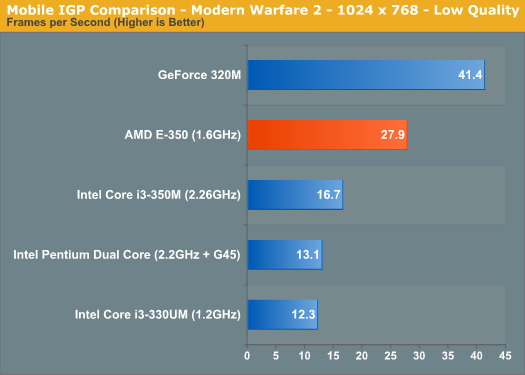
The E-350 puts the i3-350M, i3-330UM and Pentium DC to shame, delivering 67% better performance. The frame rate is just shy of being totally smooth however. I found that in most modern games 1024 x 768 would result in frame rates just under 30 fps.
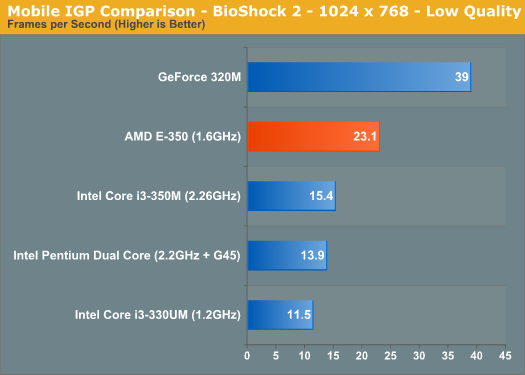
BioShock 2 showed a similar performance advantage. Again we're not able to break 30 fps but the performance advantage is huge compared to the Intel platforms with integrated graphics.
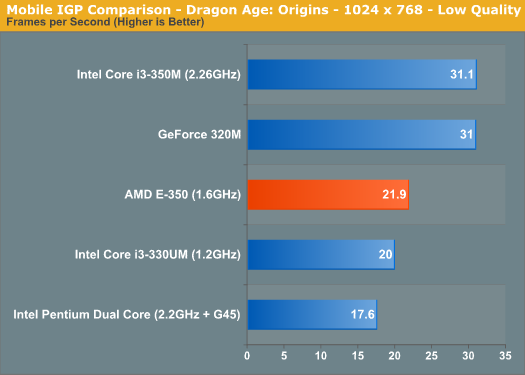
Dragon Age: Origins is mostly CPU bound at low quality settings and thus there's no real advantage to the E-350's Radeon HD 6310 GPU. It's faster than the Pentium/G45 platform, but significantly slower than the i3-350M. I expect most games however to be GPU bound at these settings across the board.
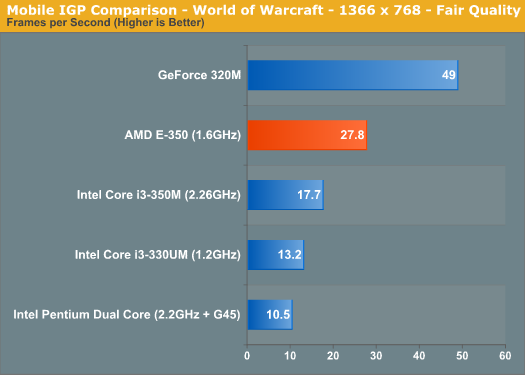
World of Warcraft continued the trend. The E-350 ended up 57% faster than the i3-350M, although still fell short of a discrete GPU.
Of course I wondered how well Brazos would play Starcraft 2:
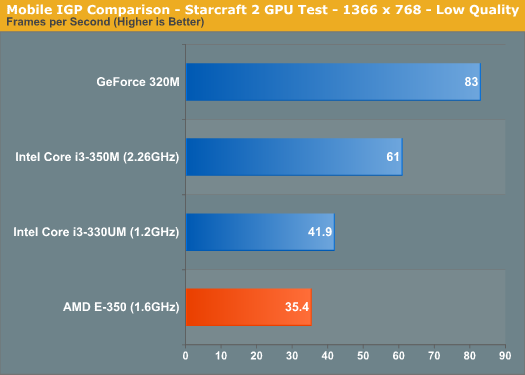
The GPU handles SC2 just fine, however the game is very CPU dependent and thus you see a pretty big advantage from the mainstream i3 system. The comparison is a lot closer when we look at the i3-330UM. The E-350 won't be able to play SC2 as well as a $500 mainstream notebook, but it'll be comparable to an ultraportable running ULV Arrandale.
We don't have numbers for the G45 platform here because the system wouldn't run our benchmark (our tests use an older version of SC2 which apparently had issues with the G45 drivers).
Our SC2 CPU test gives you an idea of the lower end of performance in large multiplayer battles:

The E-350 offers only 58% of the performance of the i3-350M system. The Bobcat cores do hold the platform back from time to time. Again, compared to the i3-330UM there's no performance difference at all.
Just for kicks I also ran the Civilization V benchmark, which gave us two datapoints: GPU performance and no-render/CPU performance.
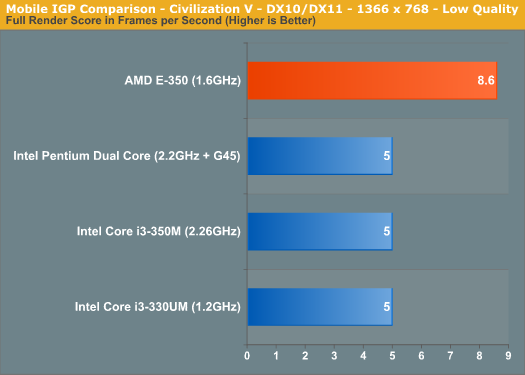
The benchmark doesn't score well on either platform, although AMD does hold a 72% performance advantage over the i3 and G45 platforms. The CPU test puts the E-350 at about 55% of the speed of the Pentium dual core platform.
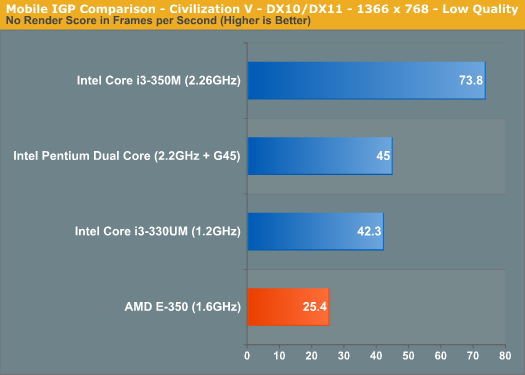
Civ V is one area where the Arrandale CPU advantage wins out over GPU performance.
Overall, the E-350 has no problems outperforming any of the current Intel integrated graphics offerings in 3D games. In CPU bound titles the E-350 loses out to the mainstream i3, but is competitive with ultra low voltage i3s. Just as with Atom, you'll have to sacrifice performance vs. a mainstream notebook, but compared to low voltage Arrandale the E-350 can hold its own.










207 Comments
View All Comments
IMPL0DE - Tuesday, November 16, 2010 - link
...underwhelming. I was hopeful to see more performance out of this one. Let this not be the sign of the things to come. I still have faith in Bulldozer.Dark_Archonis - Tuesday, November 16, 2010 - link
If Bulldozer underwhelms or disappoints, AMD might be finished. I don't see how AMD could continue to be in business if two of their major new products are both underwhelming.For AMD's sake, Bulldozer needs to extremely competitive, at the very minimum.
wiak - Tuesday, November 16, 2010 - link
AMD Radeon is one line you should not underestimate ;)GeorgeH - Tuesday, November 16, 2010 - link
Bulldozer is only a piece of the puzzle. AMD's killer chip is the one that seamlessly combines what will (hopefully) be a Bulldozer core's awesome integer performance with the floating point performance of a GPU, all with competitive mobile power consumption and a process node that will allow them to make a decent profit while competing with Intel on price.Kevin G - Tuesday, November 16, 2010 - link
That will come in 2012 with the successor to Llano.The thing that AMD needs to be worried about is getting Llano out in a time frame to be competitive. It has seemingly been pushed into the middle of 2011 instead of the early 2011.
Dark_Archonis - Tuesday, November 16, 2010 - link
Great, we've been hearing that for years. First we heard that AMD's "killer product" was going to be a combination of a CPU and GPU, except they got beat by Intel on that front.Now, AMD's "killer" product apparently will be a Bulldozer CPU combined with a good GPU.
It seems that AMD's "killer" product is a continually changing target, and is something that may never arrive.
What if the competition is much stronger by the time AMD releases a Bulldozer Fusion product? What will the "killer" product for AMD be then I wonder?
Oxford Guy - Tuesday, November 16, 2010 - link
Well, years back, AMD was generally crushing Intel with its crappy NetBurst line. That may never happen again, but it was fun while it lasted. The problem for AMD is that Intel has to really screw up for it to have a chance, given Intel's leverage. An absurd design like Prescott is unlikely to come again.Dark_Archonis - Tuesday, November 16, 2010 - link
That's really the point. Even if Bulldozer is very impressive, for AMD to make financial or market share gains, Intel has to stumble. By all accounts, Sandy Bridge will be a very strong product.As I say, Intel stumbling on the scale of the P4 Netburst fiasco is unlikely to happen again. Intel is very well known in the industry for learning from their mistakes.
GeorgeH - Tuesday, November 16, 2010 - link
AMD hasn't been beaten to anything yet. CPU/GPU hybrids aren't about slapping a classical IGP together with a CPU. CPU/GPU hybrids are about combining the compute performance of a CPU with that of a GPU into a single flexible unit.Intel is moving towards that target with good CPUs and substandard GPUs. AMD is moving towards that target with substandard CPUs and good GPUs. If/when/where they meet is the point where AMD has the potential to deliver an awesome product.
Sandy Bridge, Llano, and the like are only the first few baby steps towards the goal, and it's silly to claim a "moving target" just because those steps aren't as large or as relatively impressive as we might like.
Dark_Archonis - Tuesday, November 16, 2010 - link
AMD should have never had so much hype behind Fusion in the first place then, as the product that you describe won't be on the market for several years.